There’s an island between the oceans of sport bikes and adventurers, occupied by sport tourers and sport adventure tourers. Some of them are too sporty to be tourers (like the Hayabusa), and some are too upright to feel sporty (like the BMW R – GS, as formidable as it is in the right hands).
But on that island is a plethora of bikes that can do the distance and still inspire a bit of feistiness in the owner. On the edge of this range is the Triumph Tiger Sport 1050, a bike I’ve had the joy of riding for the last six months.
I wanted to share a little about what makes the Tiger Sport 1050 an underrated, fun, and surprisingly affordable (used) adventure sport tourer. In short, I like this bike! There’s so much to like about the Tiger Sport that there’s literally nothing to dislike. This is a bike that gets it ALL right. Well, nearly. It’s a bit heavy. But not even too heavy! And anyway, aside from that, the Tiger Sport (1050) is agile, powerful, comfortable, and easy to ride at every speed and in every place I’ve taken it, from dirt roads through suburban backstreets to highways at speed.
I bought this bike sight unseen. I knew I’d be spending at least a few months in Melbourne, Australia (though I’ve bought a place here — so I’ll be here for around half a year every year from now on!, and that I’d need a steed to get me around the city. I didn’t know much about riding around the city — I know a lot more about it now! — so I just did what I usually do and browsed the local marketplaces (Facebook, Gumtree, and Bikesales being the most relevant ones) and looked for something that could do it all.
The Triumph Tiger Sport 1050 was it. Here’s what makes it great.
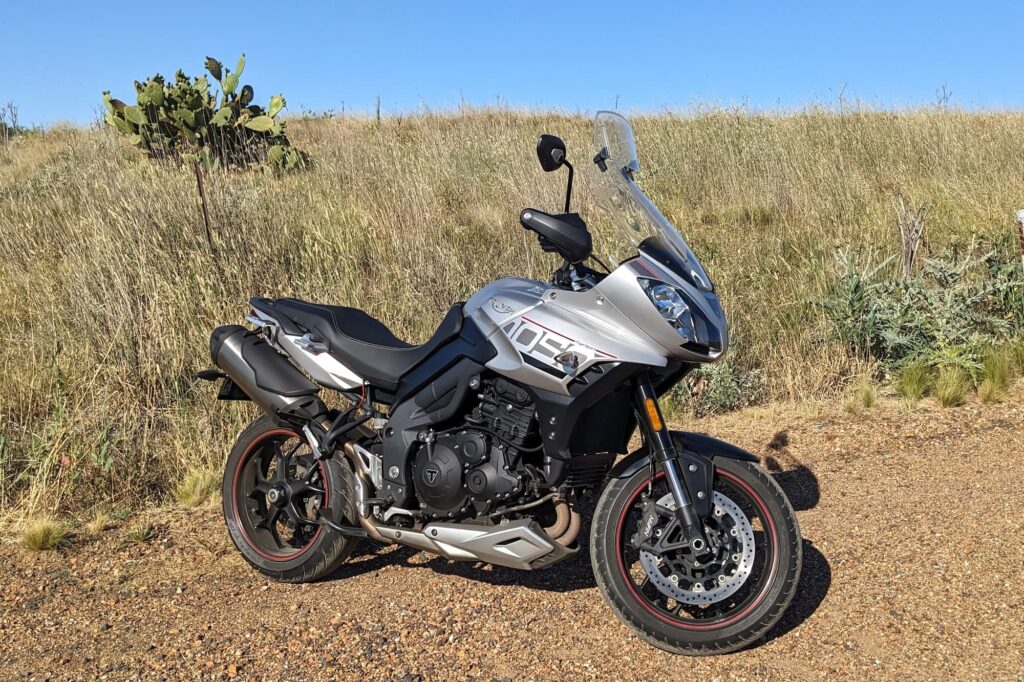
Are you obsessed with motorcycles?
Well, I am. That’s why I created this site — as an outlet. I love learning and sharing what others might find useful. If you like what you read here, and you’re a fraction as obsessed as I am, you might like to know when I’ve published more. (Check the latest for an idea of what you’ll see.)
Just What Is the Triumph Tiger Sport 1050?
The Triumph Tiger Sport 1050 is a bike that has a mouthful of a name, but your really have to say all of it, because one must be clear exactly which Tiger of which capacity we’re talking.
Everything’s a bloody “Tiger”! It’s like Kawasaki and Ninja. So many things are Ninjas or Tigers that one starts to question what the word even means.
Basically, a “Tiger” seems to be any bike from Triumph that’s “upright and comfortable”. They span sport touring to adventuring. The Tiger range has included bikes with displacement from around 800 to 1200, shaft drives and chain drives, spoked 21-inch front rims and cast 17-inch front rims, and a large range of weights. Though one thing they’ve all had in common, at least, is three-cylinder engines.
If you say “Triumph Tiger Sport” these days, most people will assume you mean the newest one — the Tiger Sport 660. The Sport 660 is a good entry-level adventure sport tourer. In fact, it’s a great bike for a lot of people. The Tiger Sport 660, like its closely related sibling, the Trident 660, is lightweight, capable, affordable, and great for most riding that isn’t sustained highway touring at speed. (Which it could do, just not as gracefully as other bikes.) Whack on cruise control (maybe with an MCCruise unit) and I’d prefer it over the 1050 just because the Sport 660 is lighter.
But the Triumph Tiger Sport 1050 is its own thing. The Triumph Tiger was always the more upright adventure-focused motorcycle, sitting alongside the Triumph Speed Triple and Street Triple, with which it has shared an engine (or a related engine, in the case of the Street Triple).
In the modern “Hinckley” era of Triumph, the first Tiger was the Tiger 900, originally launched in 1993.
The Triumph Tiger 900 (model number T400), affectionately known as the “Steamer”, was powered by an 885 cc three-cylinder engine that made a modest 61 kW / 82 hp at 8000 rpm.
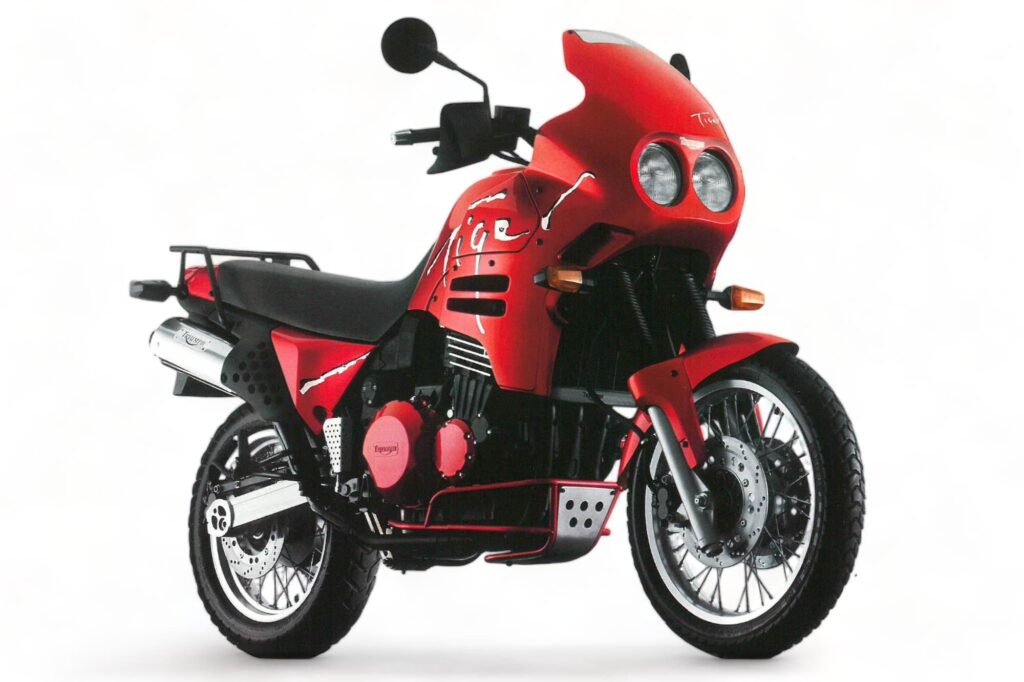
The “Steamer” was pitched as a touring enduro bike (or adventure tourer, as we call them these days), with spoked rims, a 19-inch front wheel, some crash protection, and an ample fairing.
Triumph updated the T400 model in 1999 to the fuel-injected version of the 885 cc engine and made it for a couple more years. Then, in 2001, Triumph introduced the next gen of the Tiger 900 powered by the more modern 955 cc fuel-injected triple. This model was known as the T709.
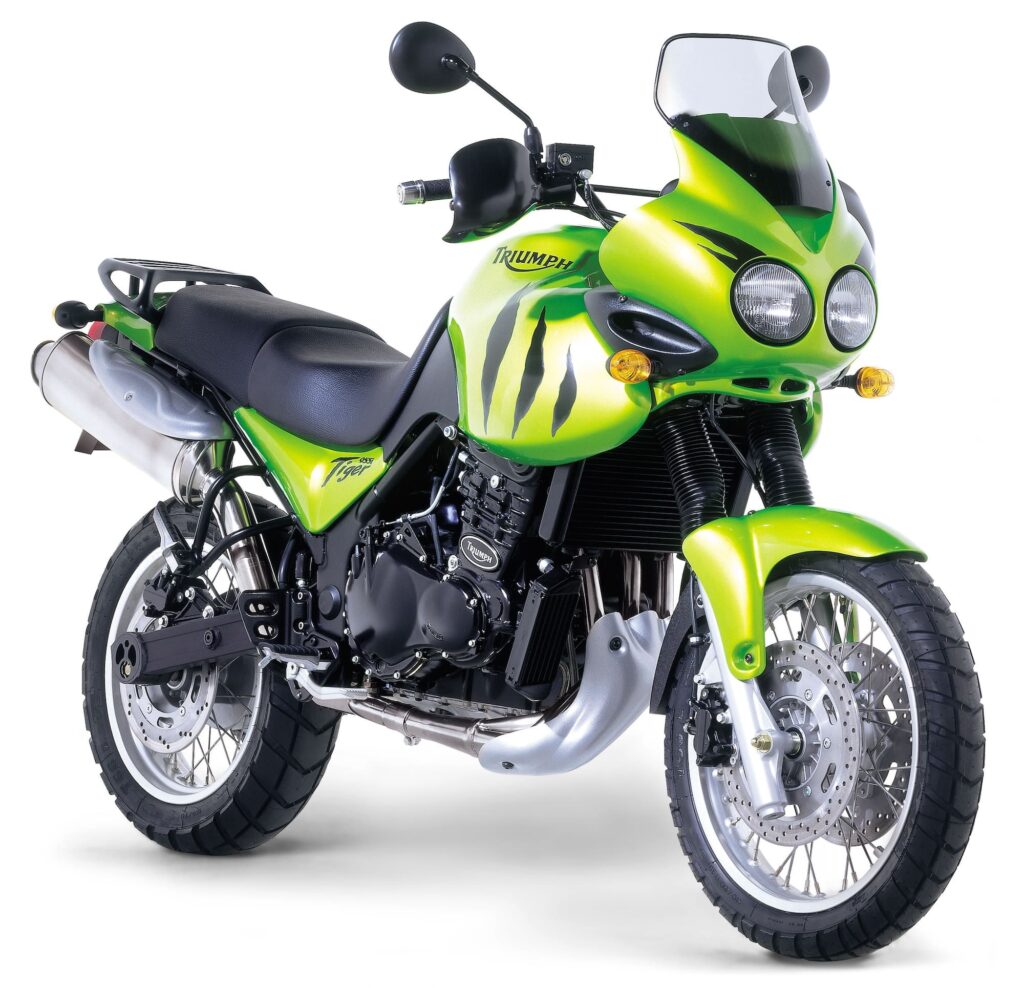
The 955i had an engine based on the Daytona 955i’s triple, so you could say it had sport bike heritage. It’d be the last Tiger to have any — as the 955i was the last big Daytona. Still, it had a 19-inch front wheel (in either spoked or cast configuration), with off-roading pretensions I suppose, and the conventional fork and geometry never made it a wonderful handler.
Then Triumph launched the Tiger 1050 in 2007 to replace it. Cast 17-inch rims, an inverted fork, and even ABS as an option from 2009. But the first 1050 was still an ancestor of the current version, with a double-sided swingarm (which some see as a con, due to the possibility of seizing) and less tech.
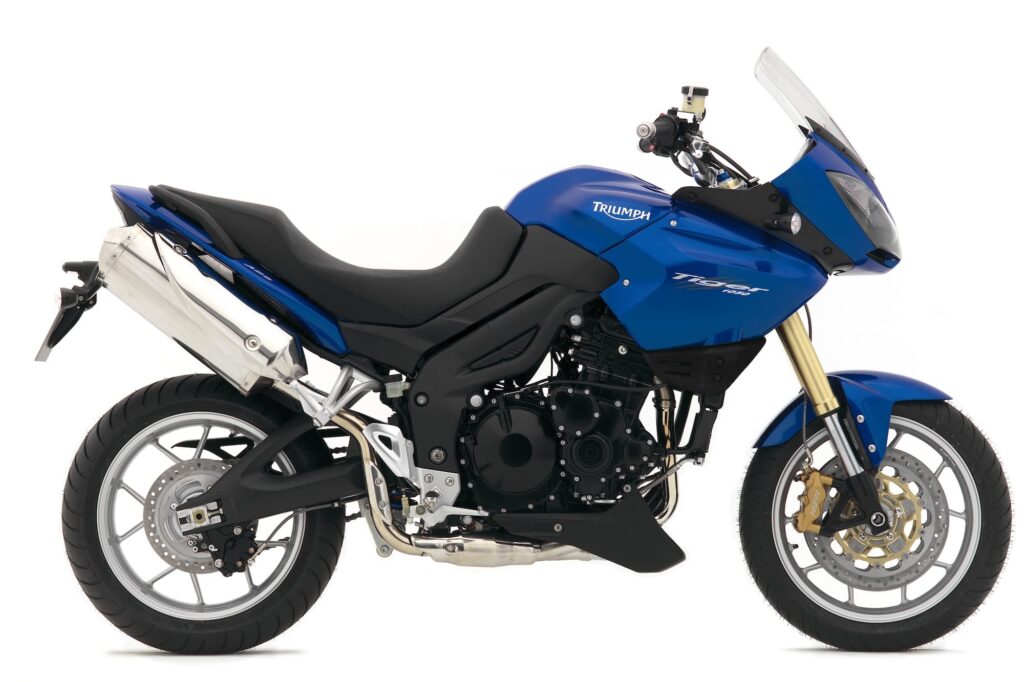
Nonetheless, the 1050 motor was here to stay. The Tiger 1050 (and Tiger Sport 1050) has a 1050 cc three-cylinder motor with the same dimensions as what you’d find in the other Triumph 1050s — the Speed Triple and the Sprint ST and GT. But the tune in the Tiger 1050 is closer to that of the Sprint ST / GT — less top-end power, and more mid-range grunt.
Triumph knocked it out of the park with the 1050 motor. It really is an engine that does everything well. It’s incredibly easy to manage at low speeds — it’s hard to stall this bike! It pulls from any gear (I think I launched it in 3rd gear once by accident when I was distracted) and has a roaring mechanical top end even with the stock exhaust. But you really need to get rid of that exhaust to unleash the noise. (You do need at least a link pipe to fit to it before slip-ons can go on — otherwise you’ll cover that gorgeous exposed rear wheel.)
In 2013, Triumph revised the Sport 1050, redesigning the fairing, giving the engine more top-end oomph, and giving the rear wheel a single-sided swing-arm. And then from 2016, Triumph gave the Tiger Sport more electronics, including cruise control. This was the last model Triumph made.

The 2013-2020 revision (in particular the 2017+ with cruise control) represents for me almost the perfect harmony of things you can want in a motorcycle.
- A three-cylinder engine: Really strikes a balance between the grunty roar of a twin and the high-pitched scream of a four. Triumph does these particularly well. And the 1050 is one of the best in the business.
- Handling: The Tiger Sport 1050 is easy to use at every speed. Low speed, high speed. Around roundabouts, along sweepers, or in country backroads. It’s difficult to fault.
- Looks: Most adventure sport tourers are ugly. No, none of them will be as good-looking as an all-out racebike or a muscly naked bike or cruiser. But the Tiger Sport does it for me — the wheels, the swingarm, the fairing, the upswept exhaust — it does the job.
- Comfort: There’s enough of a fairing to keep the wind and rain off you. The suspension works very — it’s plush without being either stiff or soft.
- Electronics: The “just enough” level. I just really like bikes that have ABS and cruise control but still have an analogue tach. TFTs are, for me, a bridge too far (though I unironically have a phone mount, anyway).
- Standard bits: I’m not sure if they were standard everywhere, but every Tiger Sport 1050 I’ve seen comes with a centre stand, luggage, and hand guards.
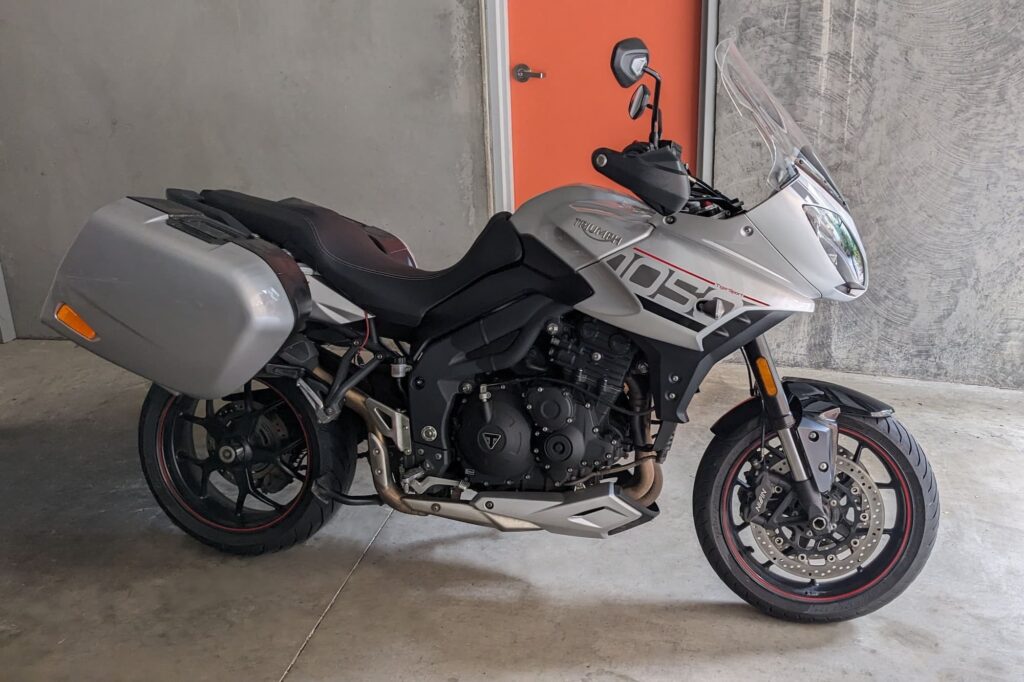
The only fly in the ointment of the Tiger Sport 1050 is that it’s not lightweight. It weighs 235 kg / 517 lb wet. “Wait,” you cry, “That’s hardly heavy.” True, it’s lighter than many bikes I’ve had, including most in the “sport touring” category. It’s lighter than my Honda VFR800, my Suzuki Hayabusa, and my BMW K 1200 RS (by a large margin). It’s only marginally heavier than my sporty nakeds, too — less than 20 kg / 44 lb heavier than my Honda 919 (CB900 Hornet). And for that weight penalty I get loads of stuff — a fairing, a centrestand, and comfort for days. (Not sure whether the saddlebags are included in the wet weight. Nor the centrestand, for that matter, but I’m editorialising).
It’s not heavy, anyway. Actually, it never feels heavy. It’s just not light. Light bikes are like the Street Triple or Yamaha MT-09 — or many other modern nakeds. They’re like toys, almost, and give you a sense of invincibility. While the Tiger Sport isn’t heavy, it doesn’t give me that same feeling. What it gives me, in exchange, is comfort and stability.
What the Triumph Tiger Sport 1050 is Like to Ride
On to the main part: Does this bike live up to its promise? Like I mentioned, I bought it sight unseen, so I really had no idea.
I mean, I had some idea. The 1050 triple is a well-known motor. I’ve seen it in other incarnations — the Speed Triple and the Sprint GT.
And I’ve also ridden sport adventure tourers before, like Multistradas, Tracers, and so on. So how does it fit in within this family?
In short, the Tiger Sport 1050 makes a mockery of most riding. There’s no place I find it unwieldy.
Riding in the suburbs, the tall riding position and relatively wide handlebars make it easy to manoeuvre at low speeds. The engine is very responsive from down low.
But on the highway is when the Sport 1050 really shines. It’s a mile muncher. I love the SUV-like riding position — I’m above a lot of traffic (not above SUVs, which do dominate the roads, along with trucks / utes or whatever you call them where you’re from). And while there are handlebars, they’re not so wide that I feel like I’m on a dirt bike or adventure bike. I remain slightly crouched forward — enough to give me a feeling of oomph when I want to go.
I picked up the Sport 1050 because of how many things it came with out of the box for a very low price of just $9990 on the road. That’s Aussie dollars. It’s even cheaper in green paper! To pay that much and get a bike with cruise control, luggage, and enough safety features for most situations meant I could think nothing of taking the Tiger on a long trip, maybe even with a pillion.
My bike came with a Givi touring screen. This I hated. Screens are entirely individual (which is what led me to this process of customising my own screen), but this one was the worst I had ever experienced — it blasted wind into my face, making any ride unbearably noisy even at 50 mph/80 km/h, even with good earplugs and a full-face helmet. Ridiculous. Anyway, after that experimentation, I bought a clip-on spoiler for some spare change and the effect was transformative — a quiet ride at any speed.
With the spoiler in place, the Tiger Sport 1050 became a bike so easy to ride on the highway that I started to actually enjoy it. I’d crank on some tunes and sing along as I squirted in nd out of traffic. After figuring out how to change the ride mode and turn off traction control, it started to feel like a veritable hooligan machine.
Putting it in “Sport” riding mode, I think, is a must. Road mode was a bit too sedate, and I didn’t even try rain mode. It probably hurts my fuel economy a bit, but oh, did I mention that the Tiger Sport 1050 runs on regular unleaded fuel? This is like an instant 20% discount on fuel! It’s amazing. The manual says it — you don’t need premium. Most new bikes require premium fuel these days. Sure, it might be good to occasionally run a tank of premium for the added cleaning benefits (which might be hocus pocus), but I’ll take the savings, thank you.
Traction control also is a fun thing to keep off. The wheel jumps up a little sometimes, and you get wheelspin in the places where you’d expect it. I find early implementations of TC a bit intrusive (I had similar feelings on my VFR800 8th gen) so turning it off was an easy decision.
It’s really interesting also looking at the Tiger Sport’s competition within its own lineup.
There are three main contenders, I think.
Firstly, its little sibling, the Tiger Sport 660.
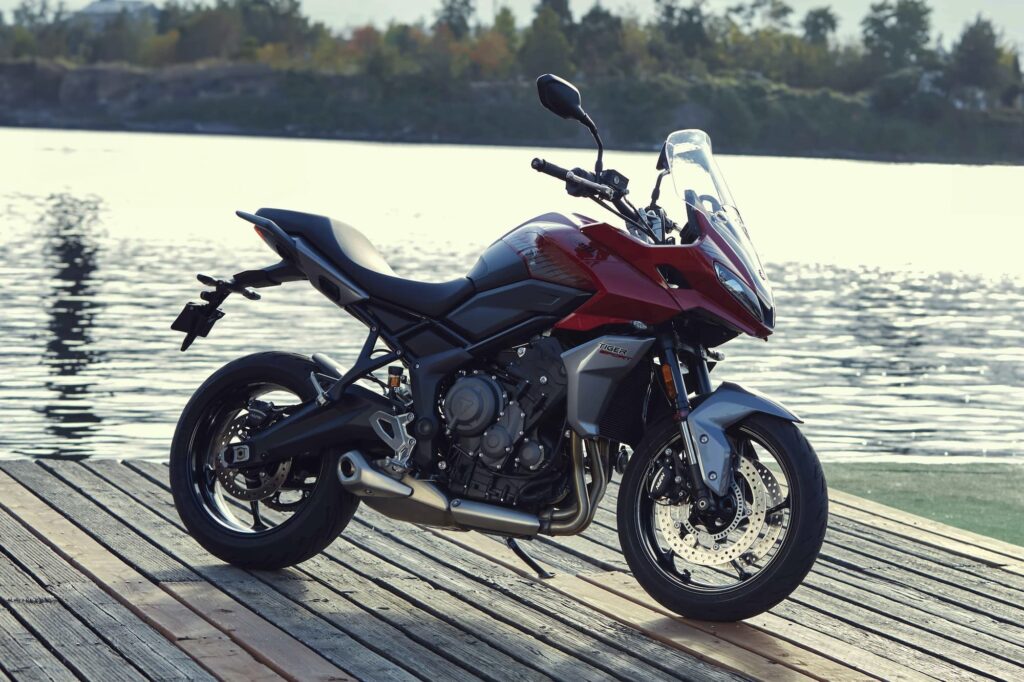
To me, the Tiger Sport 660 is the principal alternative. It’s really a fun little bike — a feisty 659 cc inline three-cylinder engine that has just enough power for a lot of everyday fun. You can wind it out on the highways, even, and get quite a lot out of it.
The Tiger Sport 660 feels a lot more modern, thanks to its TFT display. But it’s just not as plush as the Tiger Sport 1050. And, needless to say, the engine doesn’t pull like the 1050’s does. It just never will.
And the 660, being a newer bike bought by a slightly different crowd, is unlikely to come with things like panniers and a centrestand. Many of the Sport 1050s I’ve seen on the used market (and they’re all used, now) have those. Plus, the 1050 has cruise control. Game over, really.
Secondly, the Tiger 900 GT.

The 900 GT and GT Pro are high-spec middleweight sport adventure bikes. They’re the road-going 900s, next to the Rally siblings. (Thank goodness Triumph changed from its XR and XC nomenclature of the previous ~10 years.)
The GT and GT Pro are awesome bikes. They’re really unlikely to disappoint. They’ve got everything! TFT display and even cornering ABS.
But they’re nearly as heavy as the 1050, so if you don’t mind getting a used bike, you don’t miss out on much by getting the older one. At least the 900s still only require 91 RON (regular) gas.
Finally, the Tiger 1200 GT.
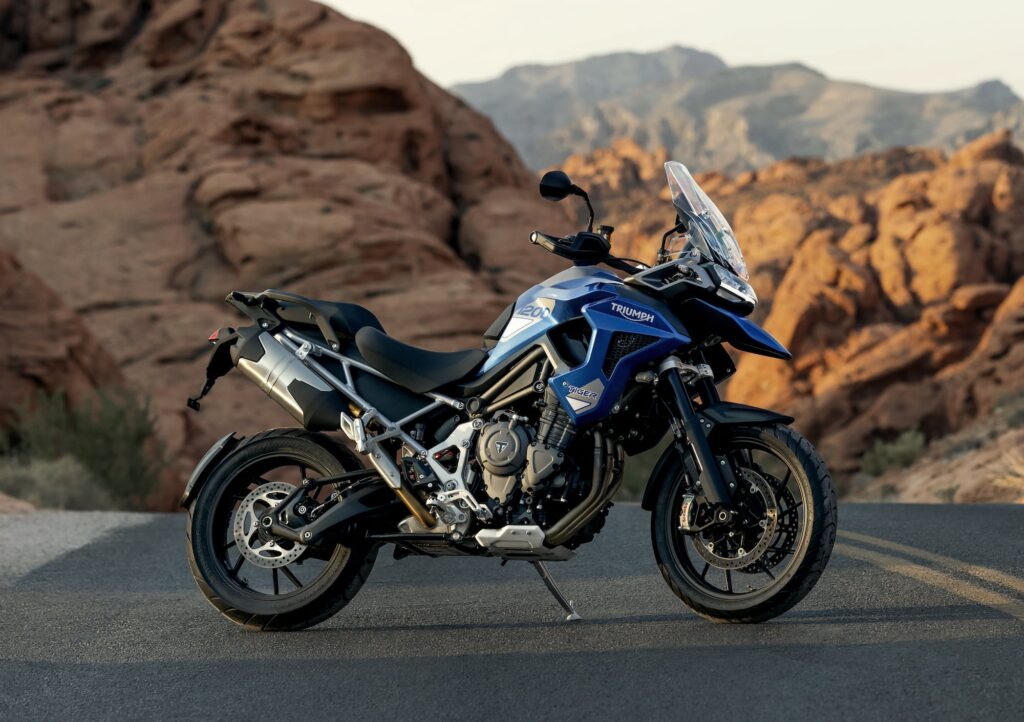
The 1200 GT has its share of detractors (Schaaf’s “Why though?” is a concise analysis), but this is the full-fat, high-spec luxury adventure tourer. With a big whopping three-cylinder engine (a higher-revving 1160 cc engine, an evolution of the previous gen’s 1215 cc long-stroke motor), shaft drive, and stuff like fully active suspension, the Triumph Tiger 1200 GT is really made for long-haul touring. Of course, it’s more expensive, and heavier.
Amid all these, it’s cool to see just how much bang for the buck you get for a used Tiger Sport 1050. You don’t get a TFT display, but for me that’s a pro. You don’t get cornering ABS, but you still do get ABS and traction control. And you get gobs of power and a reasonable amount of weight.
Gosh, putting all that together, I’m really going to be sad to see it go.
Seven Neat Features of the Tiger Sport 1050
Here are, in convenient listicle format, a few reasons why the Tiger Sport 1060 is worth attention.
Firstly, the engine.
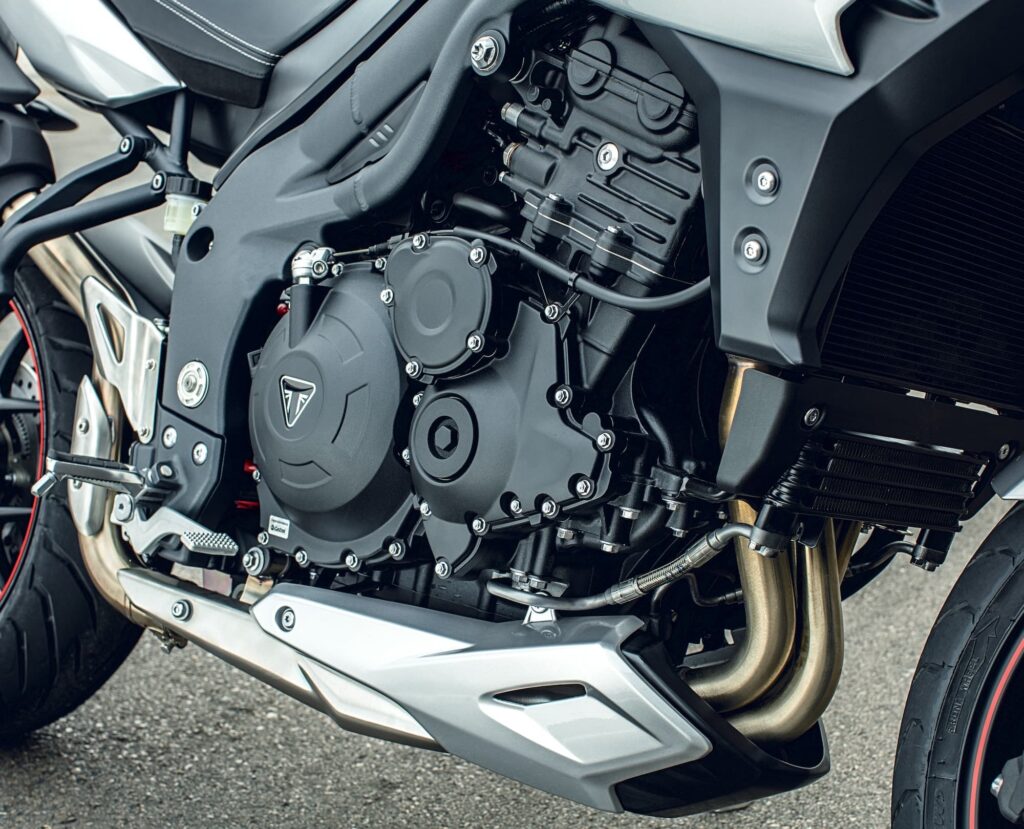
The Tiger Sport 1050’s engine is a three-cylinder 1050 cc engine that does it all — it has character, it has revviness, and it has low-end torque.
In the 2016-2020 version of the engine, the engine is tuned for 93 kW (126 PS / 123 bhp) at 9475 rpm, with torque peaking at a very accessible 7000 rpm.
Yes, people like the Speed Triple 1200’s motor even more. But there wasn’t a Tiger Sport 1200 — Triumph went in a different direction with the Tiger range, and there hasn’t been anything like it since.
The ana-digi display.
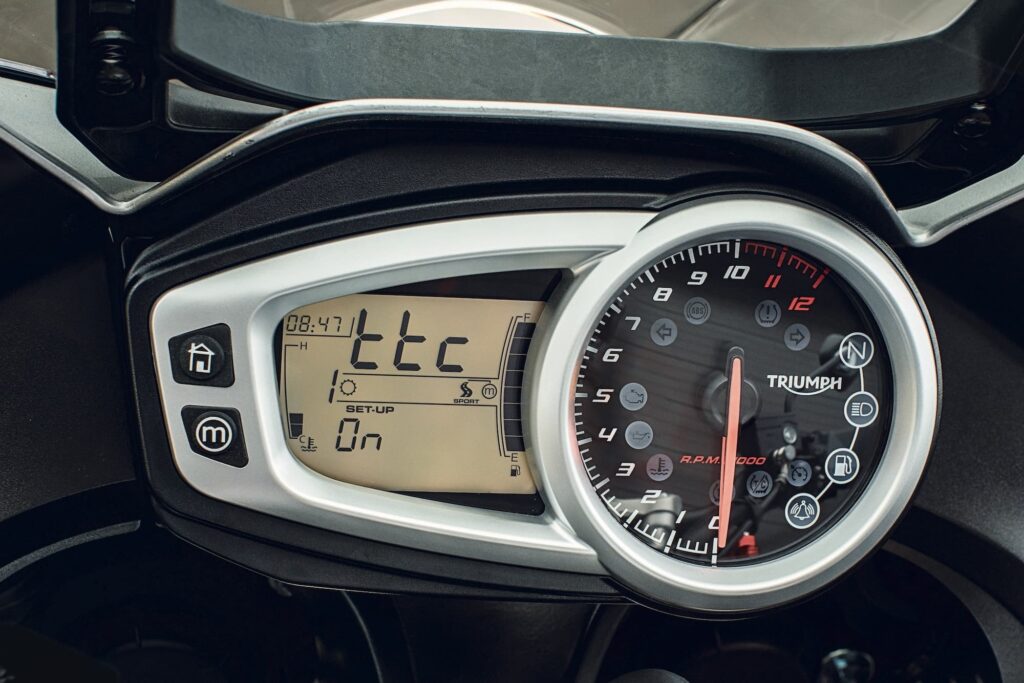
I’m a huge fan of the generation of bikes in the late 2010s that had analogue/digital displays but still lots of other modern tech. I don’t know, I just like a needle moving along a display. If you’re with me, then this is a pro!
I do like TFTs, for the record, when they let me not use my phone at all (like with Apple Carplay or Android Auto). But those cases are rare.
Ride aids (just enough). The Tiger Sport has ABS, traction control, and ride modes. For most people, that’s too much! I quite like ABS as it’s designed for unexpected road conditions (e.g. losing traction when braking on a suddenly slick surface).
Cruise control. I harp on about cruise control a lot. It’s particularly because I have a nerve condition that means I find it hard to keep my hand on the throttle for extended periods — I need to relax it. Anyway, it’s a popular feature, and people have their reasons for wanting it. On a mile-muncher, it makes particular sense.
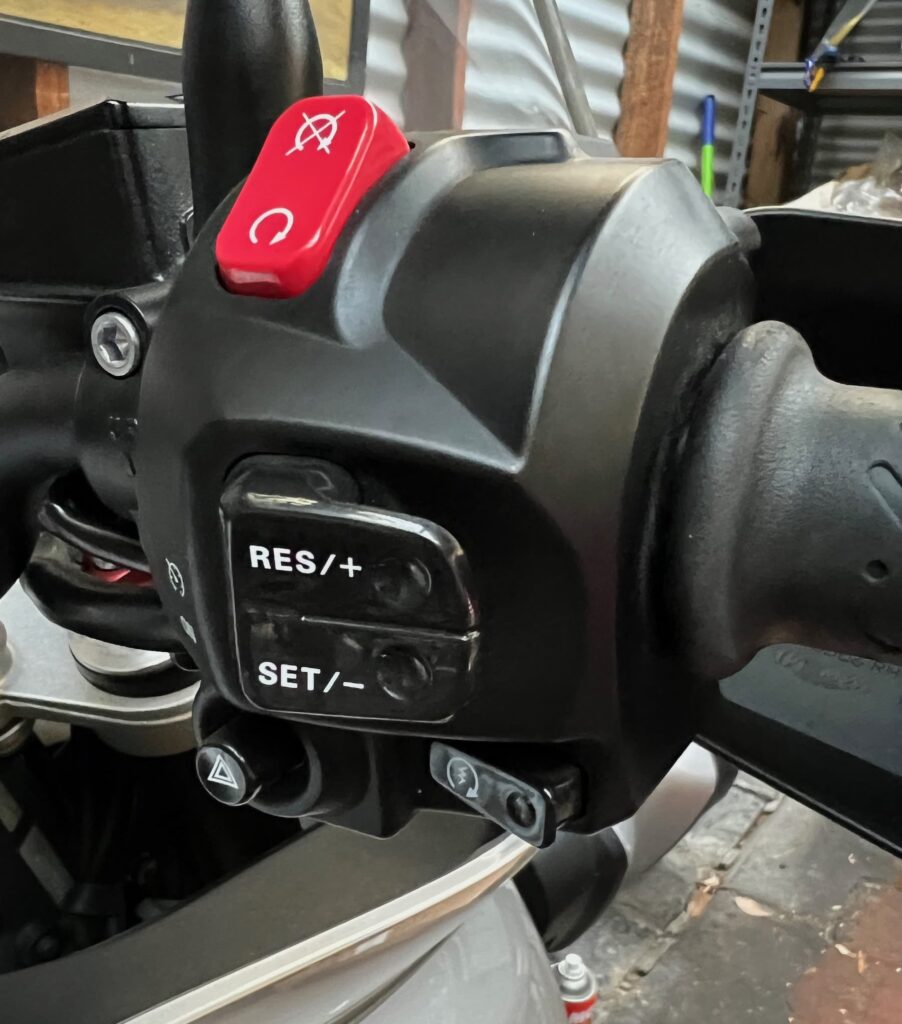
Using the cruise control with the throttle hand does take a slight bit of getting used to. I prefer bikes that have the cruise buttons on the left and the throttle on the right. But it’s not hard, and I can see the argument in favour of having speed-related on the one side.
A centrestand. Death, taxes, and chain maintenance. Having something that helps me clean and lube the chain — especially when one of my other bikes is up on the stand at home — is always welcome.
Luggage (that isn’t ugly). Yeah, you can throw panniers on anything. But integrated luggage always looks good. The Tiger’s luggage does the job well.
One caveat with luggage is that it does limit exhaust options. You can either install a low exhaust, or a super expensive one… but you can’t throw on a slip-on (look, I’ve been guilty) without risking melting through the panniers. Caveat emptor!
Decent looks for the class. Finally, adventure sport tourers can be plain looking (like the Tracer) or just unattractive (like the old Multistrada… I mean, I love it, but I’m weird that way). But the Tiger Sport 1050, with its modern fairing and single-sided swingarm, looks good.
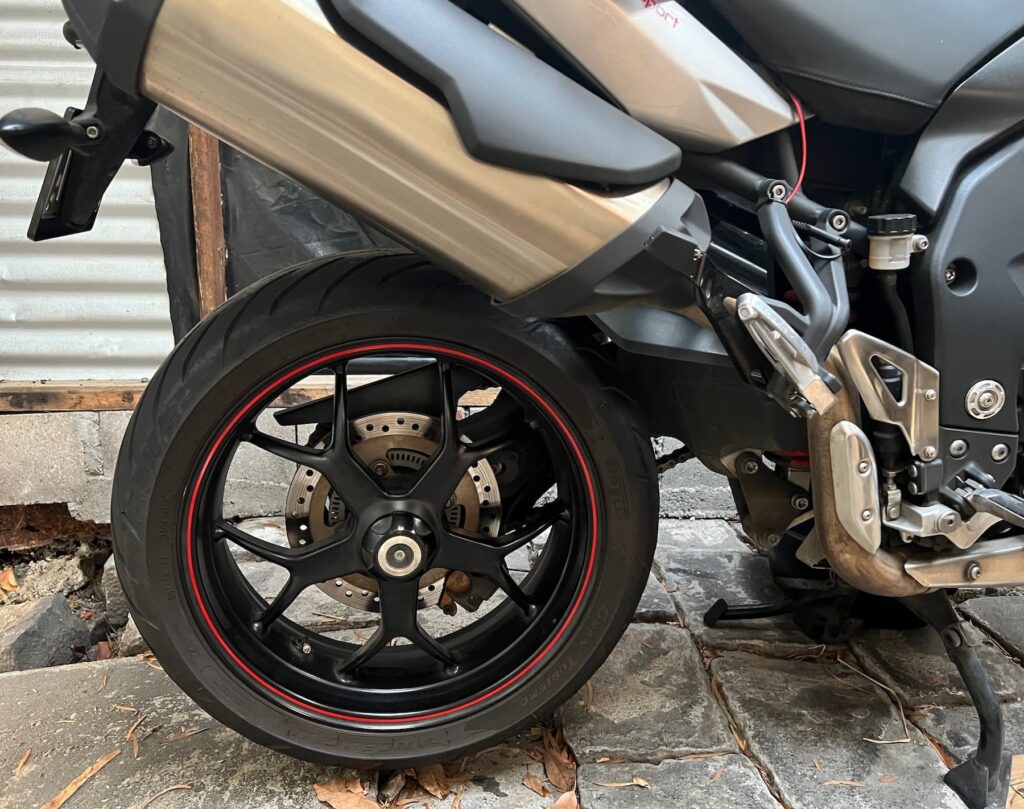
Wrap up
The only reason I’m selling my Tiger is that I’m leaving the country (again, I do this every year for a bit). I hate leaving bikes sitting, paying for their registration. So this one’s going. There’s always another one around the corner, as harrowing as the search is every time!
But I really have enjoyed my time with it. If the idea of a comfortable do-anything bike that has “enough tech” without sticking a screen in your face tickles your fancy — or if you just want the best bang for your buck sport tourer with cruise control — then the Tiger Sport 1050 is a compelling proposition.

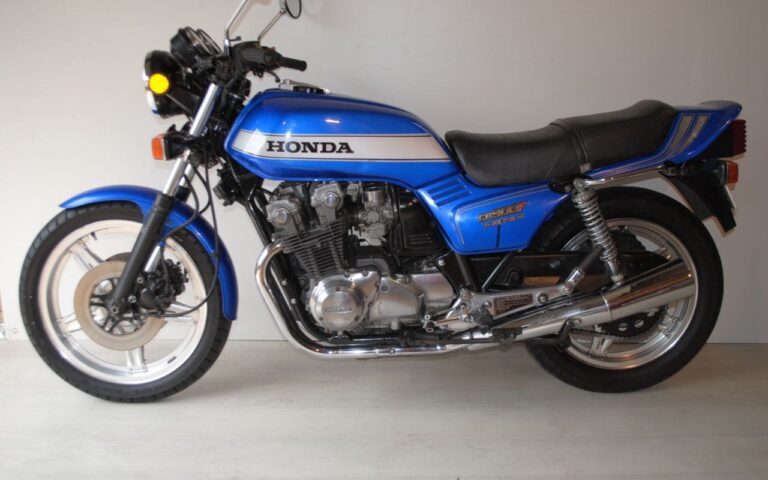
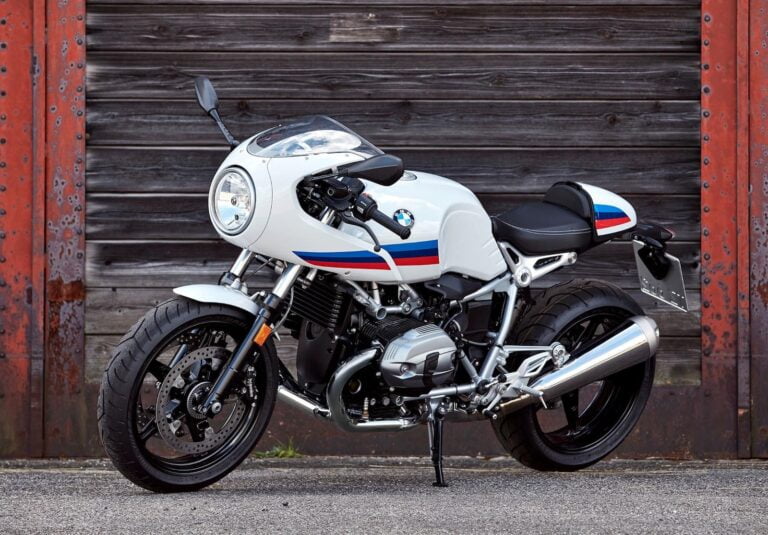
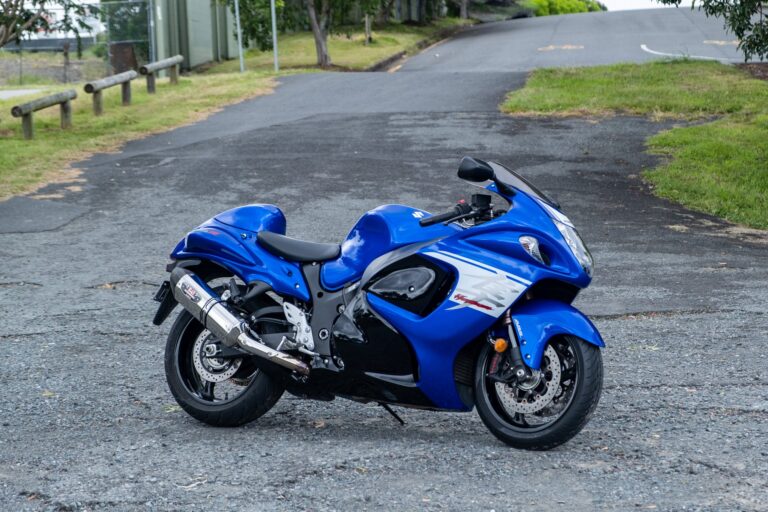
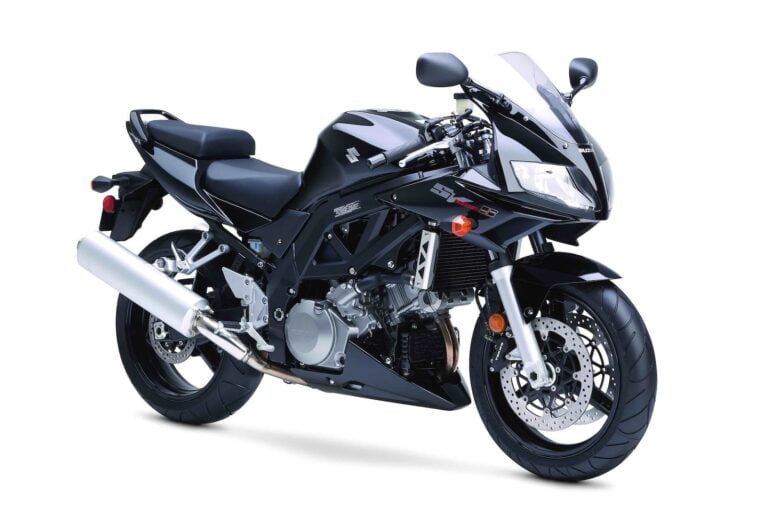
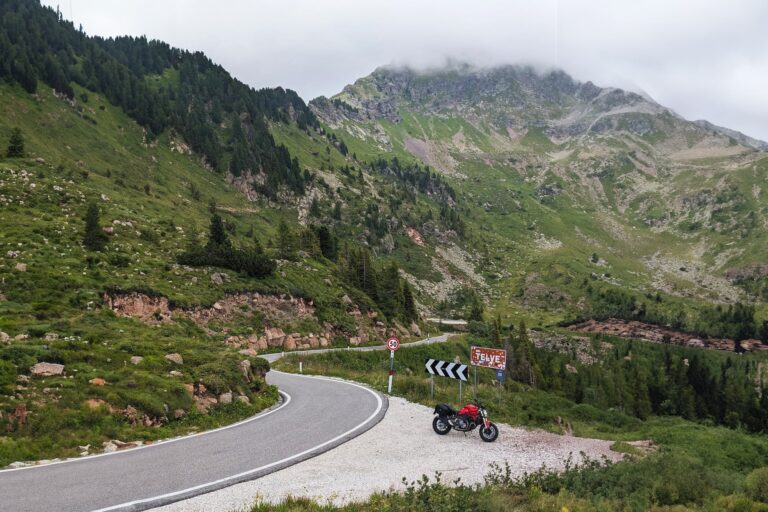
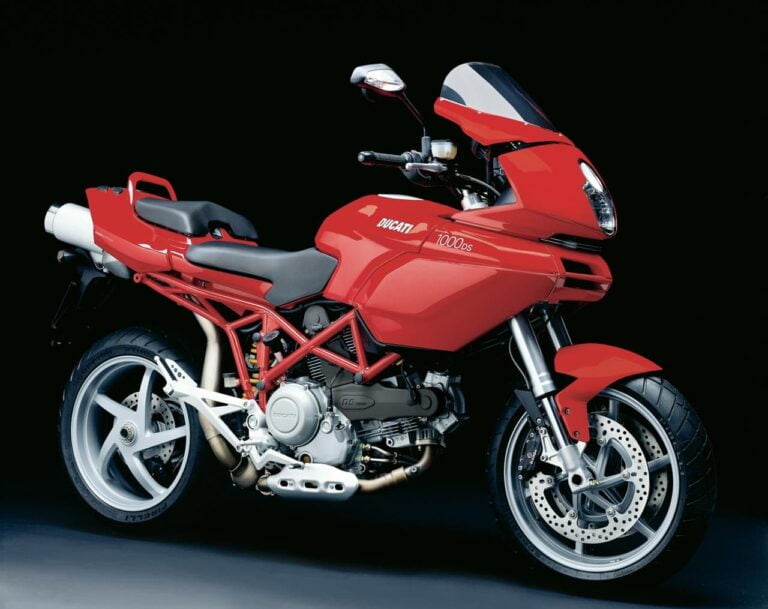
Triumph fell behind in the global market with its Tiger Trophy 1050 SE when it discontinued this model in 2014, just as a Japanese manufacturer—whose name I’d prefer not to mention—began utilizing the CP3 engine. Had Triumph developed a 900cc sport-touring motorcycle with road-friendly characteristics earlier, they could have been a top contender, especially alongside Japan’s renowned triple engine bikes.
Great write up Dana, been waiting for some new material from you. Sounds like a great bike. I’m not into much highway riding and don’t care for cruise control. I’ve found that the smaller Tiger Sport 660 fits my bill perfectly, may look into for a future bike. The whole Triumph Tiger lineup is impressive though, sure there’s an appropriate one for everyone out there. Glad you’re back.
Rode a 800 Tiger, very nice all around bike. Lots of tq. great susp., I should have bought one oh next time . Great to see you back,how have you been.
Been very busy lately — got a house, and have a lot of work to do on it. Also, have been very busy on a different business front!